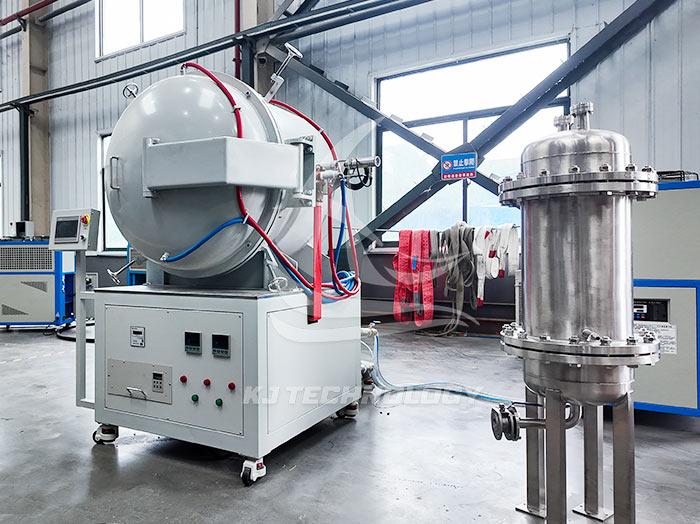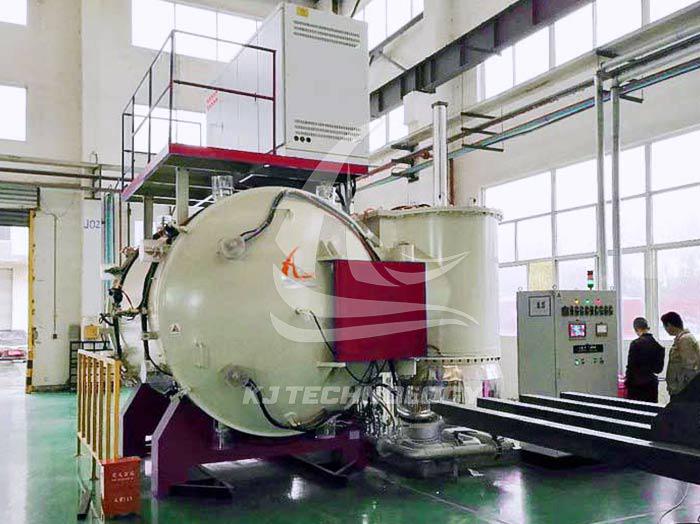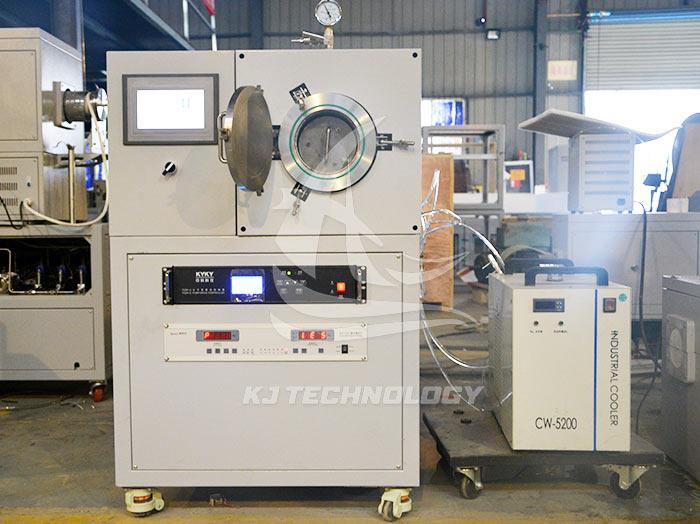Working principle of electric heating vacuum brazing furnace
 09-24-2025 Author: KJ technology
09-24-2025 Author: KJ technology
Electric heating vacuum brazing furnace is a specialized equipment that uses electric heating technology to achieve precise connection of metal materials in a vacuum environment. Its working principle integrates vacuum technology, electric heating technology, and materials science. The core is to create a high vacuum environment and accurately control the temperature, melting the brazing material and filling the gaps between the base materials, forming high-strength and corrosion-resistant welding joints. The following is a detailed step-by-step explanation of its working principle:
1. Creating a vacuum environment
Composition of vacuum system
Vacuum pump group: usually composed of mechanical pump (roughing pump), Roots pump (booster pump), and diffusion pump (high vacuum pump), gradually reducing the pressure inside the furnace through multi-stage pumping.
Vacuum valve: controls the gas flow path and switches between rough pumping, fine pumping, and pressure holding stages.
Vacuum gauge: Real time monitoring of the vacuum level inside the furnace, commonly used types include resistance vacuum gauge (low vacuum) and ionization vacuum gauge (high vacuum).
Vacuum pumping process
Rough pumping stage: The mechanical pump is started to reduce the pressure inside the furnace from atmospheric pressure (about 10 ⁵ Pa) to the level of 10 ⁻¹ Pa, eliminating most of the air and water vapor.
Fine pumping stage: Roots pump and diffusion pump are started in sequence to further reduce the pressure to 10 ⁻ Pa~10 ⁻ Pa (high vacuum). At this time, the residual gases in the furnace are mainly light gases such as hydrogen and helium.
Pressure holding stage: Close the vacuum valve to maintain stable vacuum inside the furnace and prevent external gas from infiltrating.
The role of vacuum environment
Prevent oxidation: Eliminate reactive gases such as oxygen to prevent the base material and brazing material from oxidizing at high temperatures, ensuring that the welded joint is bright and dense.
Reduce volatilization: Reduce the volatilization loss of low melting point elements (such as zinc and magnesium) in materials, and maintain the stability of welding quality.
Improving Wettability: In a vacuum environment, the wettability of the brazing material on the base material is significantly improved, which is beneficial for filling small gaps.
2. Working principle of electric heating system
Heating method selection
Resistance heating: Joule heating is generated by energizing a resistance wire (such as iron chromium aluminum, nickel chromium alloy) or graphite heater, suitable for medium and low temperature brazing (300 ℃~1000 ℃).
Induction heating: using an alternating magnetic field to generate eddy current heating in metal workpieces, with fast heating speed and high efficiency, suitable for high-temperature brazing (>1000 ℃) or complex shaped workpieces.
Radiant heating: Heat is radiated to the workpiece through infrared lamps or graphite reflector plates, suitable for uniform heating over a large area.
Heating process control
Temperature sensor: using S-type thermocouple (platinum rhodium 10 platinum) or B-type thermocouple (platinum rhodium 30 platinum rhodium 6), with high measurement accuracy, good stability, and can withstand high temperatures (up to 1800 ℃).
Temperature controller: Based on PID (proportional integral derivative) algorithm to adjust heating power and achieve precise temperature control (temperature control accuracy ± 1 ℃).
Heating curve setting: Based on material characteristics (such as melting point of base material, melting point of brazing material) and process requirements, set the heating rate (usually 5-50 ℃/min), holding time (1-30 minutes), and cooling rate (natural cooling or forced cooling).
Temperature uniformity guarantee
Furnace design: Adopting a double-layer water-cooled structure to reduce heat loss; Install multiple layers of insulation screens (such as molybdenum, tungsten, graphite) inside the furnace to reduce temperature gradients.
Workpiece placement: evenly distribute workpieces to avoid obstructing heating elements; Improve heat conduction by using heat equalization plates or graphite trays.
Airflow circulation (if applicable): During the forced cooling stage, inert gas circulation is driven by a fan to accelerate workpiece cooling and improve temperature uniformity.
3. Implementation of brazing process
Selection and placement of brazing materials
Solder type: Choose silver based, copper based, nickel based, or aluminum based solder according to the composition of the base material and process requirements, ensuring that the melting point of the solder is at least 30 ℃ lower than the solidus temperature of the base material.
Solder form: It can be in the form of wire, sheet, powder or paste, and precise control can be achieved through manual placement, mechanical spraying or prefabricated solder pieces.
Placement of brazing material: Ensure good contact between the brazing material and the base material, cover all areas to be welded, and avoid missed or virtual welding.
Division of brazing stages
Preheating stage: Slowly raise the temperature to below the melting point of the brazing material (such as 200 ℃~300 ℃), eliminate the moisture and gas adsorbed on the surface of the workpiece, and reduce welding defects.
Brazing stage: Continue to raise the temperature above the melting point of the brazing material (usually 30 ℃~50 ℃ higher than the melting point of the brazing material), and maintain it for a certain period of time (such as 5-15 minutes), so that the brazing material fully melts and wets the surface of the base material.
Insulation stage: Maintain the brazing temperature, promote element diffusion and metallurgical bonding between the brazing material and the base metal, and form a dense welded joint.
Cooling stage: Reduce temperature at a controllable rate (such as 10 ℃/min~50 ℃/min) to avoid thermal stress cracking caused by rapid cooling; If rapid cooling is required, high-purity inert gases (such as N ₂, Ar) can be filled to accelerate cooling.
Formation mechanism of welded joints
Wetting and spreading: After melting, the brazing material spreads along the surface of the base material under surface tension, filling gaps and eliminating gases.
Element diffusion: Atomic interdiffusion occurs between the brazing material and the base metal at the contact interface, forming a solid solution or intermetallic compound, enhancing the strength of the joint.
Solidification crystallization: During the cooling process, the brazing material transforms from liquid to solid, forming a uniform and fine grain structure, which improves the corrosion resistance and fatigue performance of the joint.
4. Key process parameter control
degree of vacuum
The higher the brazing temperature, the stricter the requirement for vacuum degree (such as high temperature brazing requiring a vacuum degree of<10 ⁻ ³ Pa), to prevent oxidation and volatilization.
temperature uniformity
The temperature difference inside the furnace should be controlled within ± 2 ℃ to avoid welding defects (such as cracks and pores) caused by local overheating or undercooling.
holding time
It is necessary to adjust according to the thickness of the workpiece and the type of brazing material to ensure that the brazing material is fully melted and metallurgical bonding is completed.
cooling rate
It is necessary to balance production efficiency and joint quality to avoid residual stress or phase transition embrittlement caused by rapid cooling.








